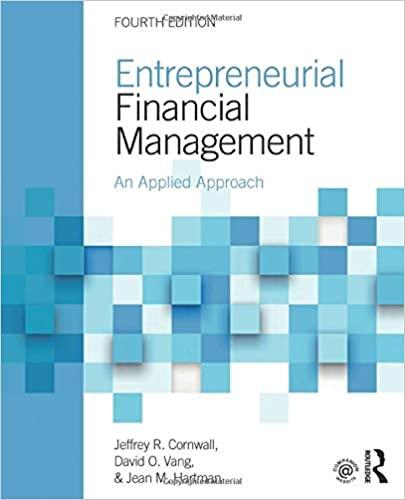Question
Spring Time Inc. is a merchandising business headquartered in the U.S. and selling primarily to wholesalers. The accounting information system is based upon the principles
Spring Time Inc. is a merchandising business headquartered in the U.S. and selling primarily to wholesalers. The accounting information system is based upon the principles and rules of U.S. Generally Accepted Accounting Principles (GAAP). Business activity is recorded on an accrual basis. The company employs the perpetual inventory system in accounting for its merchandise inventory. Sales revenue is recorded at the point of sale net of customer discounts. Purchases of inventory are recorded at invoice price. Spring Time operates using a January through December fiscal year. The balances of the accounts in the general ledger as of November 30 of the current fiscal year are as follows: (Assume all balances are normal balances.)
| 110 | Cash | 65,900 |
| 111 | Accounts Receivable | 200,200 |
| 112 | Allowance for bad debts | 2,110 |
| 113 | Allowance for sales returns | 1,900 |
| 114 | Inventory | 256,400 |
| 115 | Estimated Returns Inventory | 0 |
| 116 | Supplies | 12,100 |
| 117 | Prepaid Insurance | 30,000 |
| 121 | Investments in Available for sale securities: Noncurrent (net) | 18,300 |
| 131 | Land | 140,000 |
| 132 | Equipment | 897,100 |
| 133 | Accumulated Depreciation-- Equip. | 289,600 |
| 141 | Deferred Tax Asset | 0 |
| 211 | Accounts Payable | 61,300 |
| 212 | Salaries Payable | 0 |
| 213 | Refund liability | 0 |
| 214 | Deferred Rent Revenue | 33,200 |
| 215 | Notes Payable (due in 8 months) | 50,000 |
| 216 | Interest Payable | 0 |
| 217 | Income taxes payable | 0 |
| 311 | Common Stock, $1 Par | 100,000 |
| 312 | Additional paid in capital | 59,000 |
| 313 | Retained Earnings | 500,800 |
| 314 | Accumulated Other Comprehensive Income/(Loss) | 1,200 |
| 315 | Income Summary | 0 |
| 316 | Dividends | 75,000 |
| 411 | Sales | 4,261,190 |
| 412 | Sales returns | 79,200 |
| 511 | Cost of Goods Sold | 2,122,100 |
| 521 | Sales Salaries Expense | 650,600 |
| 522 | Advertising Expense | 220,000 |
| 523 | Delivery Expense | 36,000 |
| 524 | Depreciation Expense-- Equip. | 29,600 |
| 525 | Miscellaneous Selling Expense | 42,800 |
| 526 | Office Salaries Expense | 357,000 |
| 527 | Rent Expense | 125,000 |
| 528 | Insurance Expense | 0 |
| 529 | Supplies Expense | 0 |
| 530 | Bad debts expense | 0 |
| 531 | Income taxes expense | 0 |
| 611 | Rent Revenue | 0 |
| 711 | Interest Expense | 3,000 |
There are 150,000 shares of common stock outstanding. During December, the last month of the fiscal year,
the following transactions were completed:
Dec.1 Received $3,000 in advance payment for December, January, and February rent of warehouse space.
3 Purchased $24,500 of merchandise on account, FOB shipping point, terms 2/10,n/30.
4 Paid transportation costs of $475 on the December 3 purchase.
7 Returned $4,000 of the merchandise purchased on December 3.
11 Sold merchandise on account, $12,700, FOB destination, 2/15,n/30. The cost of the merchandise sold was $7,600.
12 Paid transportation charges of $300 for the merchandise sold on December 11.
13 Paid for the purchase of December 3 less the return and the discount.
15 Received payment from customers on account, $8,430. Amount received is net of discount.
22 Received payment on account for the sale of December 11, less the discount.
23 Purchased supplies on account, n/30 $500.
27 Paid sales salaries, $2,300, and office salaries, $1,400.
28 Sold merchandise for cash, $16,500. The cost of the merchandise sold was $11,200.
30 Paid rent on parking lot for December, $1,000,
31 Paid cash for a web page advertisement, $400.
INSTRUCTIONS: ROUND ALL AMOUNTS TO THE NEAREST DOLLAR, AS NECESSARY!
2. Journalize (using the General Journal) the transactions for December.
3. Post the December journal entries to the General Ledger, computing the year-end balances after all posting is completed.
Step by Step Solution
There are 3 Steps involved in it
Step: 1

Get Instant Access to Expert-Tailored Solutions
See step-by-step solutions with expert insights and AI powered tools for academic success
Step: 2

Step: 3

Ace Your Homework with AI
Get the answers you need in no time with our AI-driven, step-by-step assistance
Get Started


